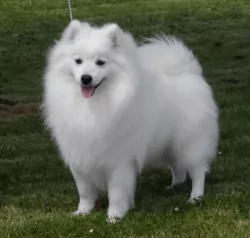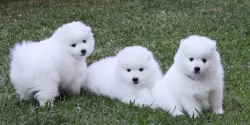 MyDogBreeds
MyDogBreedsSpitz is originated from Russia but Cypro Kukur is originated from India. Spitz may grow 20 cm / 7 inches shorter than Cypro Kukur. Spitz may weigh 50 kg / 110 pounds lesser than Cypro Kukur. Spitz may live 4 years more than Cypro Kukur. Spitz may have more litter size than Cypro Kukur. Spitz requires Moderate maintenance. But Cypro Kukur requires Low maintenance
 A spitz is not a breed of dog, but rather a “group or family” of dogs that has its roots in Germany. Within this family there are a variety of breeds that were bred for very specific purposes by people in many different parts of the world. The spitz family can be toy dog size up to vey large. Examples run from the Pomeranian to the Canadian Eskimo Dog.
A spitz is not a breed of dog, but rather a “group or family” of dogs that has its roots in Germany. Within this family there are a variety of breeds that were bred for very specific purposes by people in many different parts of the world. The spitz family can be toy dog size up to vey large. Examples run from the Pomeranian to the Canadian Eskimo Dog.
The Spitz family dogs share the look of thick, long fur and pointed muzzles, ears and curly tail. Despite their German name, they are thought to originally be of East Asia or Artic descent. Most of today’s spitz are from Siberia’s Artic region, first described in 1788 and in English in 1792. Spitz have been bred for three types of jobs depending upon where they were developed. These jobs included pulling, herding and hunting.
There are very powerful and large Spitz breeds that pull or hunt large game. Examples of these breeds are the Swedish Elkhound, the Akita Inu, the Norwegian Elkhound and the Karelian Bear Dog. The smaller sized breeds like the Samoyed hunted small mammals and birds, while the Finnish Lapphund, Lapponian Herder, and Swedish Lapphund herded, hunted and pulled small sleds.
The three largest spitz also pulled sleds throughout the 17th and 18th centuries. In most places the Canadian Eskimo Dog, the Alakan Malamute and the Greenland dog were used in sled racing and fur trapping while in Canada and Alaska the Siberian Husky was used for the same things.
Recently there have been genetic tests that show a large number of dogs that are considered Spitz type so share many strong ancestral ties and DNA similarities with wild wolves. It is now believed that a lot of these breeds were intentionally mated with wolves and some were accidental. Both domestic and wild dogs are included in this history.
Most spitz are made for cold weather, even today’s lapdogs, like the Pomeranian, do not do well in hot climates.
The Cypro Kukur is an ancient dog breed which originated in the Kumaon area of India. It is interesting to note that the name Cypro Kukur translates to Cyprus Dog, but the dog doesn’t appear to have originated in Cyprus.
The dog was used to guard livestock. It has a history that goes right back to about 300 years BC. The true history of this dog is shrouded in mystery and there are researchers who believe that foreign explorers to the Cyprus region imported these Kumaon watchdogs. There are those who believe the dog descended from the Molosser dog breeds.
The dog is also known as the Indian Mastiff or Kumaon Mastiff, but it is facing extinction with just a small number of pure Cypro Kukur remaining in the area. Today, however, there appears to be quite a large number of the dogs in Europe.
 Most of the spitz breeds share a “look” that includes erect ears, stocky heavy, usually double coats, a pointed muzzle, thick, fluffy ruffs and a heavy curled tail carried high over the body. Build for northern climates they are insulated by a undercoat that is waterproof and dense and a less dense topcoat. Their ears are small to prevent frostbite and their paws have thick fur to protect them in the frigid, icy terrain.
Most of the spitz breeds share a “look” that includes erect ears, stocky heavy, usually double coats, a pointed muzzle, thick, fluffy ruffs and a heavy curled tail carried high over the body. Build for northern climates they are insulated by a undercoat that is waterproof and dense and a less dense topcoat. Their ears are small to prevent frostbite and their paws have thick fur to protect them in the frigid, icy terrain.
Many still have wolf-like looks and tendencies. Some are very difficult to train to be companions – the Akita, Chow and especially the Karelian Bear Dog – fall into this category. Many mixed breed dogs are also considered members of the Spitz family. These dogs are easy to recognize as spitz because of these physical characteristics
The Cypro kukur is a large dog standing at anything from 70 – 90 cm and also weighing in the region of 70 – 90kg. He has an attractively lean, muscled body. He has a large head with a strong neck and floppy ears. The tail is long. The short, thick coat is a light fawn color with brindle markings or he can be white with black marking.
The Cypro Kukur is an aggressive dog breed and that is why he was used to guard livestock to ward off wild animals. He makes an excellent guard dog. However with training and socialization he makes an excellent family pet, becoming friendly and obedient around other pets and people.
 1.Children friendliness excellent with almost all the breeds. Be careful of size. Smaller breeds may not be as friendly and larger may knock down small children.
1.Children friendliness excellent with almost all the breeds. Be careful of size. Smaller breeds may not be as friendly and larger may knock down small children.
The large Cypro Kukur is a fairly aggressive dog who makes for an excellent guard- or watch dog. It is important to have this dog trained and socialized as he can be aggressive.
He may be large and intimidating to look at with some aggressive tendencies, but with training they can become domesticated and then he has the capability of becoming quiet, well behaved and obedient.
If you’re looking for a large, loyal friend, then choose the Cypro Kukur, as with socialization he can make a good and loyal family pet.
 It is a little harder to characterize the health issues of a family of dogs than it is a .will overheat in hot climates due to their double coats. Here are some propensities of dogs in the Spitz family.
It is a little harder to characterize the health issues of a family of dogs than it is a .will overheat in hot climates due to their double coats. Here are some propensities of dogs in the Spitz family.
• Thrombopathia bleeding disorder with the risk of a hemorrhage, platets don’t clot.
• Larger breeds are affected by Elbow and Hip dysplasia that can cause arthritis and lameness.
The Cypro Kukur can live to be 10 – 12, but he is a large dog and there will be some health concerns that your dog may never develop but are worth knowing about. These are Hip Dysplasia and Gastric Torsion.
Hip dysplasia is one of the most commonly occurring conditions that dogs have to contend with so it is worth knowing about.
It is an hereditary disease that progressively gets worse with age. Your dog can be uncomfortable and in pain. Canine hip dysplasia is when the head of the femur bone doesn’t fit properly into the hip socket. Veterinarians tell us that most dogs are actually born with normal hip joints, but that gradual subluxation brings about the development of abnormally shaped hip joints.
Gastric dilatation volvulus is another name for gastric torsion, a medical condition also referred to as a twisted stomach.
Excess gas causes what is known as bloat and its a life-threatening condition that will require immediate attention from your vet.
You’ll notice your pet’s stomach is swollen, your dog will have difficulty with breathing and he may be vomiting. It is a disease brought on by a number of factors.
 1Feeding the puppy The Spitz family has high energy needs but in a slow-release so they need protein more than grain. Puppies should be fed 3-4x a day in small meals. Don’t overfeed them.
1Feeding the puppy The Spitz family has high energy needs but in a slow-release so they need protein more than grain. Puppies should be fed 3-4x a day in small meals. Don’t overfeed them.
2.Feeding the adult – The Spitz type dog stores their energy to use in extended periods when working or playing. They will become obese if overfed or if they don’t get enough exercise. Feed 2-3X a day in small or medium sized meals, even the larger breeds because of their storage of calories.
4. Games and Exercises – Having been bred for endurance and stamina most Spritz breed need plenty of exercise, lots of space and lots of play. They love to run, jog, or play games. They are outdoors types who love to hike, and run or walk for long times over long distances. They are great in cold, wet weather but not so good in the heat. How much exercise they need depends on the size and history of the specific breeds. Most love to play with other dogs, so dog parks and dog day care can both be good choices for most of them. Agility, barnhunt, field trials, pulling games are all good choices.
This is a large dog and he will require an adequate amount of exercise. He is the kind of dog that isn’t recommended for couch potatoes. He will need to join you in your walks every day, or you can allow him to join you with your jogging or cycling.
The short coat of this large dog is easy to care for. He is a moderate shedder so a good brush twice a week will be all he needs to remove loose hairs and keep his coat healthy and shiny. Brushing him gives you the chance to check him for fleas and ticks too.
Other grooming for the Cypro Kukur should include trimming his nails and brushing his teeth twice a week with canine-approved toothbrush and toothpaste. Make a point of checking inside his ears as dogs with floppy ears are prone towards ear infections.